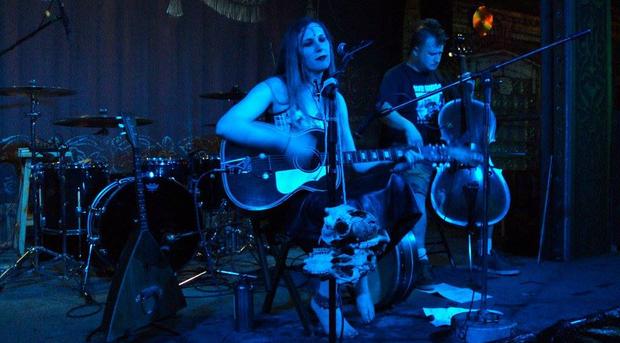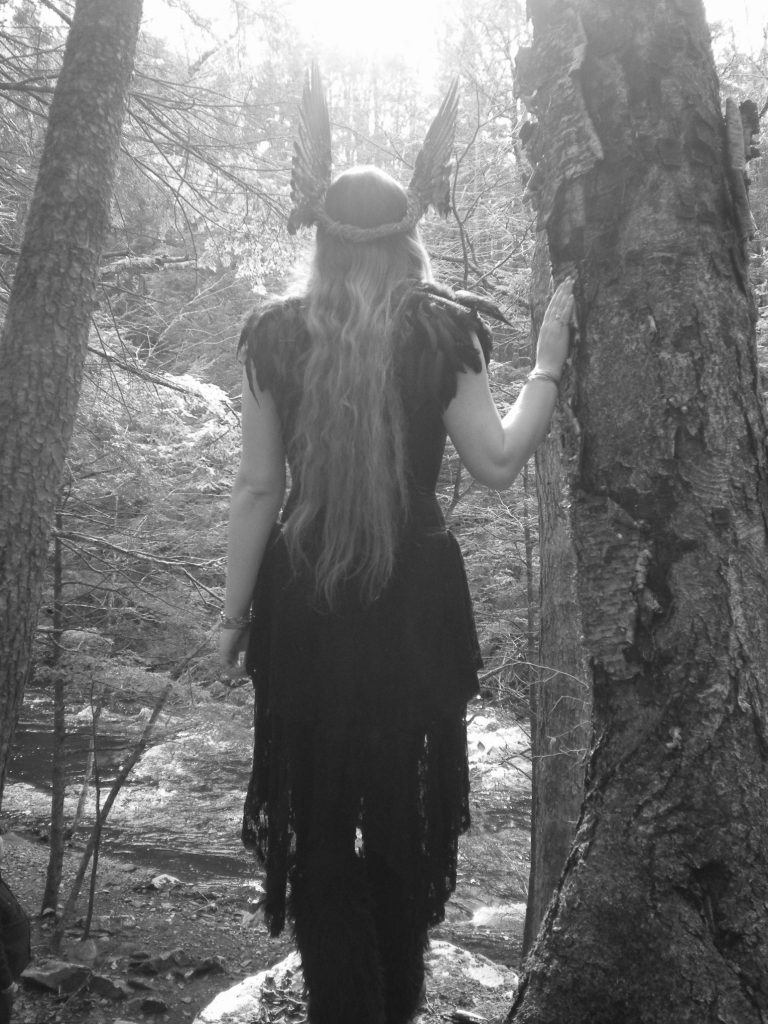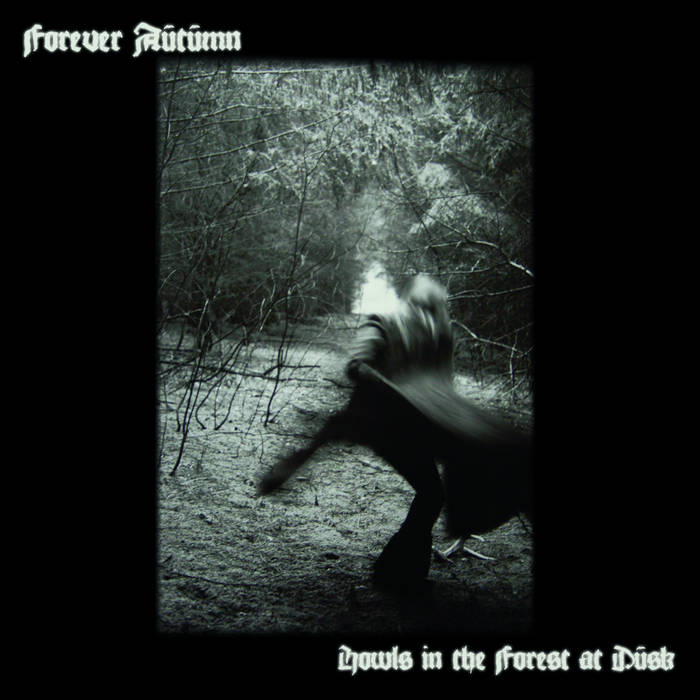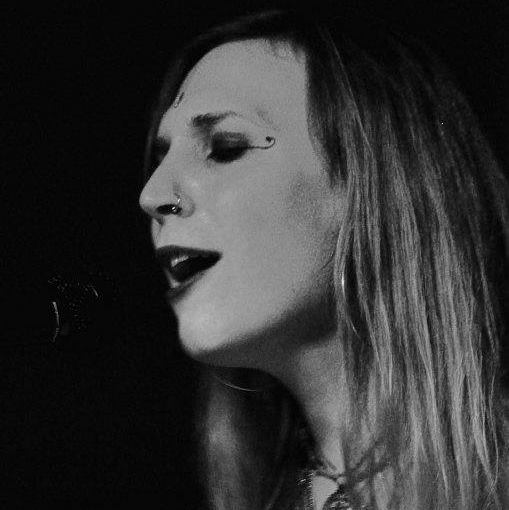
TIME IN THE TIMELESS REALM
Interview with FOREVER AUTUMN
By: Lord Randall
From its doom’ed beginnings, Massachusetts’ FOREVER AUTUMN (in the persona of Autumn Ni Dubhghaill) quickly morphed into stark, yet beautiful neofolk brilliance, shimmering on the pond in some moments, striking lightning through the mountains in others – sometimes within the same song. Earlier in this year, did Lord Randall spend a time of communion with the woman behind the music of her newest, Howls In The Forest At Dusk, and the Nature behind us alle. Here…listen, for it beckons…
Rebel Extravaganza: Twelve years lapsed between I Bury My Face In My Hands and the first full-length. When you first laid AT to rest, would you have been content just leaving it lie fallow, or did you feel the need – calling, maybe? – to rekindle that particular fire under the same name, as opposed to starting completely anew?
Forever Autumn: The original version of Waiting For Oktober waes recorded in 2005 seeing a limited hand-made release until proper CDs were manufactured in 2008. In your question however, it waes a long tyme. During those years I had gone back to college a few tymes to try agayne at my art degree. It ultimately took me nine years and three schools but I finally completed it. FOREVER AUTUMN waes never actually laid to rest. I had been writing and performing during those seemingly empty years, though the next release would not be realized until 2014. All of these releases have been self-funded independent releases. At tymes, the money may not be available to me to do as much as I would like.
RX: Part of the draw of doom in the traditional sense is the feeling of hypnosis fueled by repetition of certain riffs/rhythms/themes within a piece of music. When it comes to FOREVER AUTUMN, is it possible that the stripping down to barest essentials (both in the studio and onstage) actually enables the listener to focus more on the feelings evoked by the music itself, and enter another state, be it trance or otherwise?

FA: That trance is essential to the shamanic influence of FOREVER AUTUMN. To some I say that our performances are an experience. If you let it in, it certainly is. When we speak of repetition of riff, rhythm, and theme, we find the real essence of Doom. In the studio I am able to add more to the atmosphere in the forms of percussion and others. During live performances, we have to omit some of the sounds of the recording but I feel, are still able to express the message of FOREVER AUTUMN and lead the willing to another world. I will change instruments on stage when needed but I try to keep it minimal as opposed to performing in the early days. The individual relation by the listener to FOREVER AUTUMN and the movement to altered states confirm that I’m doing it right.
RX: If you would, delve a bit into the lyrical inspiration behind ‘Balalaika Fire Song’.
FA: Certainly. In ‘Balalaika Fire Song’ we find the compared similarities between living beings and the element of Fire. Many aspects of personality are described in a way in this piece. There are those who “…smoulder, plume smoke to the air, as a signal, a sign, or a mark of despair.” Some of us may not accomplish anything of note, just plodding along through life. A call through smoke may at tymes be seen. It is a vehicle of expression by way of signs and of communication. Smoke signals have been used for ages, but in ‘Balalaika Fire Song’ they work in many different ways. It may be a cry for help from those locked in suffereing, or a warning to others. There are those personalities that consume all in their path whether in enlightenment or destruction. They are only halted by the shores of the sea where their fuel ends and the world transforms. However, they have certainly made their mark on the land and its populace. Then there are those are contained “…in a small iron box. Some live their lives in a circle of rocks.” These people do not venture out of their imposed limitations, for they are either content, or ignorant that anything can exist beyond what they can see or are told. The piece ends with the words; “I don’t know where I’m going I cannot quite see. We are Fires in darkness, we burn to be free!” Indeed we are all Fires in darkness, illuminating what is around us, but it is difficult at tymes to see past our own light into the darkness beyond. Fire burns to be free, to escape it’s imposed bonds and go where it will. We too will always yearn for more.
RX: I’ve recently finished a book entitled The Stranger In The Woods, about Christopher Thomas Knight. He simply “walked into the woods” one day at age 20, and wasn’t captured, seen or spoken to – aside from two unintended run-ins with campers/fishermen – in 27 years. I understand that call of the forest, that desire to sometimes “disappear” into the heart of Nature, and by doing so, find oneself simply part of that heart. The music on the new album definitely conjures those same sentiments. How important is it for you to be “in the environment” in a physical sense when writing material?
FA: The influence of the mountains, the forest and the natural world are paramount. It is essential that I be in, near, or have access to the wilderlands in order to glean inspirit as well as escape this new modernity, if only briefly, in a place I can understand. I am pleased that you can see and feel that connexion between myself, my werke, and your described sentiments. Though I may not bring my instruments with me on these many adventures as I used to (for I like to keep my hands free for running about, climbing trees and foraging forest gyfts).
RX: Is ‘The Forest I Know So Well’ about a specific woodland? An area close to home…well of inspiration, maybe?

FA: Yes, ‘The Forest I Know So Well’ is a commentary on the march of tyme within an area close to home. It is a space along the northern portion of the Appalachian Trail. This woodland, I felt for many years, waes for me to protect from the incursions of humanity and ‘progress’. Being located on the Appalachian Trail, I became used to hikers passing through, though I would oft not let my presence be known. Over the years, as they often do, things change. It haes, however, only been in recent years that the major changes have occurred which have been serving to drive me away. More people move to the area, buy land and clear it for building lots. My ways into the forest haes become more and more limited and a new rash of the disrespectful plague the land. Chief amoung their defilement is the marking of deer and animal trails. These may be hunters or just some dumb kids. I did my best to meticulously cover over the now spray-painted trees, but they returned agayne and agayne to make it even worse, and more out of reach. If they are hunters, I am disappointed. A true hunter would not need to vandalize the forest. These and other experiences have driven me out of what had always been a safe place for me. The mere signs of a human presence often incites a nervous paranoia. This piece, ‘The Forest I Know So Well’, is an expression of the alienation I feel from this ‘progress’. I now realize that there is nothing I can do to protect this area, feeling like I failed in my duties. Like the wyld animal, I am driven out and expected to adapt and survive in a foreign environment. I miss the trees. We have formed bonds and friendships over the years. As expressed in the lyrics; “…I wonder if they think on me?”
RX: With the music of FA being as sparse as it is instrumentally, do you find it of extreme importance that every element act in synchronicity and symbiosis in order to arrive at the sound you desire for each song? It’s not so much that you’re wondering “Should I add more drumming here?” as “Should I have drumming at all?”
FA: The sparse and spread elements of FOREVER AUTUMN instrumentation are very important to the successful sound, feel, and expression of each piece. Ev’ry element should act in synchronicity, yes, but there is a level of the organic that comes into play. The tyme I keep in each song may quicken or slow. It took Jon some tyme to adjust to this. Sometymes, the song becomes more than what the initial intention waes, as the organic once more takes play in the outcome. It is important to me that the musique be allowed to move and grow where it will, with but the gentle touch of my hand to direct it. It is true that the addition of sounds can often involve questions like yours; “Should I have drumming at all?” I do not require that the same instruments be the only ones heard. Earlier releases have seen the addition of didgeridoo and Irish chanter to name a few. Over the years I seemed to have filed the instrumentation down to a few core instruments, but they are never to be required. I am always gathering and learning more instruments and incorporating them into my werke. The piece may tell me what it needs. I try not to force it.
RX: Do you often find yourselves the “odd band out” on the bill in live settings? Do you feel – on the whole – that the more traditional doom/metal crowd “gets it” more than the folk/neo-folk scene, or vice versa? Do you see enough similarities that they might be said to blend?

FA: Indeed I often find us the “odd band out”. As far as I can tell, that haes always been the case. We have played with Doom bands, Punk bands, Metal bands, Goth bands, Folk bands, et alia. We always seem to never quite fit in. It can be on those strange bills that we do not find receptive audiences, but sometymes we are surprised. I am not sure what to say about the traditional Doom/Metal crowd. I feel that there will always be the arguement about FOREVER AUTUMN whether it is truly Doom or not, though personally I feel that it very much is. So, it can be a toss-up between Doom and Metal fans as to how far they are willing to move out of their self-imposed bounds. I have found a great reception amoung the Doom Scene over these many years. Doom-metal.com ranks amoung our most staunch supporters. As to the folk/neo-folk scene, that seems another thing altogether. We have not had to pleasure to perform with many, if any, neo-folk bands. I have often felt that to be a scene Forever Autumn would do well in, but we don’t really have access to it. I have tried to join various online groups and find some sort of neo-folk nexus point, but when I share FOREVER AUTUMN it seems to fall on deaf ears. I do enjoy much of the traditional neo-folk, though I am still searching for connexion with the contemporary. Do they blend together? Yes, I feel that they do. FOREVER AUTUMN haes often been a blurred line between the two. There are fans of both sides that could enjoy it. However, I have also found over the years, especially when it comes to shows, that we are oft’ too metal for the folk crowd, but too folk for the metal crowd. There are exceptions of course, but this haes become a recurring theme. As stated, they do blend. They are the perfect ford through the dark divisive river. FOREVER AUTUMN, if not myself, have always bordered on the in-between. The ability to walk between worlds is essential to my own well-being, as well as my creative werkes.
RX: Plans for the remainder of the year?
FA: We are currently in conversation with DEEP DARK RIVER about a potential tour in the summer. Otherwise, we are still booking throughout the year. I do plan to keep promoting Howls In The Forest At Dusk, playing as many shows as possible, and beginning work on what may become the next FOREVER AUTUMN album tentatively entitled The Lamentations. Thank you for this interview. It haes been a pleasure.
FOREVER AUTUMN Online:
Official Site
Bandcamp
Facebook